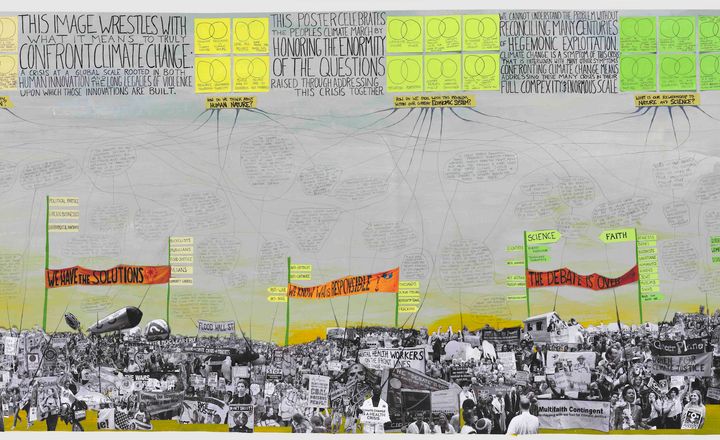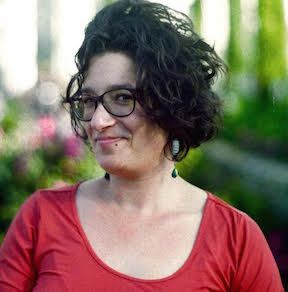
Last week, Huffington Post published a piece of mine called Confronting the Climate Crisis: A Job for Artists?. In it, I talked about a piece of art I made called (similarly to the title of the article) Confronting the Climate: A Flowchart of the People’s Climate March, I’ve been overwhelmed by the enthusiastic response to this new project. One thing I hear people say a lot is: this would be such a great image to teach young people able climate change! And, of course, I agree! The good folks at the Alliance for Education also printed this interview with me about the potential I see for this image to be a tool for educators to ignite conversation about climate change with young people. And this got me thinking: really wouldn’t it be more powerful to share what educators themselves are saying?

Today, a range of teachers who had expressed enthusiasm about this project are sharing their plans for it. These educators live and work across the USA and Canada, and represent a full range of subject matters and disciplines (math, science, debate, art, english, history). They teach elementary, middle and high school, in public and private schools, in both urban and rural settings, plus at a youth-run farm and a homeschool program. Each teacher gave some concrete examples of how they might integrate the image in to their curricula--and they remind me what fantastic creative thinking teachers everywhere do in their lesson planning each day---most often quietly or thanklessly.
Reading these educator’s fantastic ideas reminds me of that the act of trying to make sense of the world is inherently human, and it is at the core of what we try to teach young people in almost any context. For this reason, teachers know that it is critical to educate their students about climate change—but that doesn’t make it easy. On top of the many confines and stresses we place on educators, climate change is an issue that many find daunting and hard to talk about at all—so how do we bring it to our classrooms?
As an artist, I made this image as a tool that tries deepen our thinking about climate change- a crisis on a global scale that intersects many of the largest problems in our world- inequality, health, safety. I sincerely hope it can amplify learning in classrooms and in many other contexts, as well. Whether you’re a teacher looking for compelling ways to bring climate change in to your student’s learning, or just a person concerned with how to engage others in meaningful conversation about climate change, take a look below at these brilliant teachers’ ideas:

Robin Messing is a retired language arts, writing, and humanities teacher and literacy staff developer, who worked in New York City public schools across three boroughs for twenty-four years.
As a former humanities teacher and staff developer, I can envision using this image in a history unit of study as a way to organize different aspects of our inquiry. When we study a particular historical moment, we ask many standard questions to understand the social, economic, and political aspects, including: Who has the power? Whose voices are not heard? How does geography affect the actions and conflicts? In general, students respond to these guiding questions in writing. But I can imagine the powerful effect of broadening our investigation and thinking by creating a visual image for the inquiry, using this flowchart as a "mentor text." In my experience, student learning and understanding is facilitated by offering various modalities of expression, art and image a critical one. The image as a prototype offers the important opportunity to remember that the study of history isn't mainly about providing answers but creating a "canvas" for investigation, which the flowchart provides. Many students would benefit from the opportunity to work with visual representations to investigate their thinking and analysis of the complex systems and relationships inherent in historical events.

Maryam Adragi teaches High School Math, Science, and Geology at Burnaby South Secondary School, Vancouver, BC, Canada
I am a math and science teacher. I want to make my classes relevant to the real world, and I want my students to be engaged in their communities and apply the lessons to what is happening outside the classroom and off campus. When it comes to climate, applying stories is such a great way to capture youths attention. Something i would be interested in doing with this poster is having students pick a type of scientists and look at what that person can do to curb climate change, or how they could work on solutions with one of the communities that are outlined on the other flags. I’d ask: What is science's role in each section of the march? If you have have a class of students choosing different projects and questions to explore, as a class you can get a much more complete story of what science can and should do to mitigate climate change and the impact.

DiCo is a Latin teacher and the Speech & Debate program director at Achievement First Brooklyn High School, Crown Heights Brooklyn.
I am a firm believer in the importance of creating a classroom space that empowers, affirms and inspires students. I would use Rachel's image as a starting point for a conversation around how our community - both locally, nationally and internationally - should respond to the escalating catastrophe of climate change. I would start by giving the kids some silent solo time to engage with the image up close and have them write on post-its what part of the image resonated the most with them and stick those notes next to the relevant spots on the image. I would then lead what we teachers call a "gallery walk" in which they look at the image again but this time pay attention to where their classmates stuck their post-it notes and what they wrote about on the post-its. Afterwards, we would come back together and share reflections as a class about what stood out to us in terms of the content of the image. I would use that lesson as a hook to start off our unit on climate change, specifically grounding the unit in an example of how we cannot approach a unit on climate change passively but instead as active agents of change.

Kevin Connell teaches food justice, climate change, and facilitation skills to people of all ages, but primarily teenagers at Grow Dat Youth Farm in New Orleans, Louisiana.
I see this poster as a powerful example for young folks. One possibility that comes to mind is to use it as a tool for envisioning collective action in our own city—as New Orleans teenagers, the young folks I work with definitely qualify as ‘Frontline Youth.’ The poster can inspire a vision of our own march in New Orleans. What do our signs say? Who’s there? What organizations would we invite? Where would we march to? This could be a conversation, an art project (we draw/collage/act out our own march), to a first organizing meeting for a youth-led action. Another idea comes from Rachel’s use of flow-charts to visually connect ideas. Young people could use the visual language in the poster to create their own flow charts. Since I work at a farm, we’d probably start with food: start with what you ate for lunch and make as many connections as possible—how does your meal connect to other people, places, resources? The simple tool of bubbles and connecting lines provides an invitation for making connections and thinking systemically.

Sarina Partridge teaches at City of Lakes Waldorf School in Minneapolis, MN. In Waldorf schools, the teacher follows their class from first through eighth grade, and teaches language arts, math, science, history, music and art in integrated thematically-focused units. Last year, Sarina taught eighth grade. This year she began with a new group of 1st graders.
I can't wait to use it in the middle grades - I see this speaking especially to 8th graders as they study modern history and current events. Often, history texts and curriculum are either a) depressing and demoralizing lists of wars; or b) smoothed out falsifications of people's experiences that gloss over oppression, or try to simplify and draw resolution out of events and issues that are unresolved. I strive to bring to middle school kids a depth of understanding of the struggles of being human, while also bringing inspiration - part of being human is the urge to rise together. I also strive to show them that history isn't a discrete chapter in a book. Humans are still living out the stories of "history" in the present, and we can learn how to grow as a world by seeing that truth. I think kids will love to see the complexity, the humanness, the beauty and the tangle of the people's climate march and the stories around it. The teens I know who are growing up today really understand that climate and the environment are their mission, their task. Can they learn to see the connections between issues, articulate questions, work together towards answers, like they see in this beautiful work? Yes, I think they can, and I also think they must.

Blair Mosner-Feltham teaches social studies at West High School in Madison, WI.
My teaching brain immediately finds two ways this image would enrich and augment my social studies classroom. The first is using the image to structure a simulation -- perhaps a mock climate summit. Simulations help school-based learning stick with students long term, and taking on characters free students up to take intellectual risks that can seem scary without the mask of a character. Students would take on roles of people in the image, using the poster and other texts to understand the perspectives of each group, and would be asked to discuss the broad questions in character.
The second is using this image as a model of a "one-pager", which is a text response strategy associated with the non-profit organization AVID (Advancement Via Individual Determination) that is popular at my school site. Students fill a page (or a poster) with images, quotes, repeated words, questions, key points, takeaways, and connections, and then use the one-pager as a grounding, individualized document for later discussion and writing. Rachel's poster would act as both inspiration and model for students as they work out complex and interconnected texts.

Jenny Lee Fowler is a working artist and educator living in New York's Hudson Valley. She teaches art workshops for people of all ages at the Center for Creative Education (CCE) Homeschool Hub, Kitchen Table Arts, New York Botanical Garden (NYBG) and other venues.
I teach an Art and Social Justice class for homeschool students ages 10-14. Each week we look at a different group or movement--and talk about the ways that people are using art as a tool to persuade, celebrate, mourn, inspire action. This past week we talked about what we understood about climate change, and we watched Rachel Schragis' Kickstarter video about her new poster, "Confront the Climate: Flowchart of the People's Climate March." Following the video, I asked the students what they noticed about her process in the video-- how she worked with people in gathering stories and ideas, choices she made, and materials that she used. I can imagine this dialogue would have been even richer if we'd had the poster on hand, but the kids picked out great details from the video. The flowchart in it's entirety presents a great visual exploration of how seemingly disparate social justice concerns can come together under the same banner.

Inspired by their plans?
Through October 28th, you can pre-order a poster today for your classroom, community center, place of worship, or for your home!!